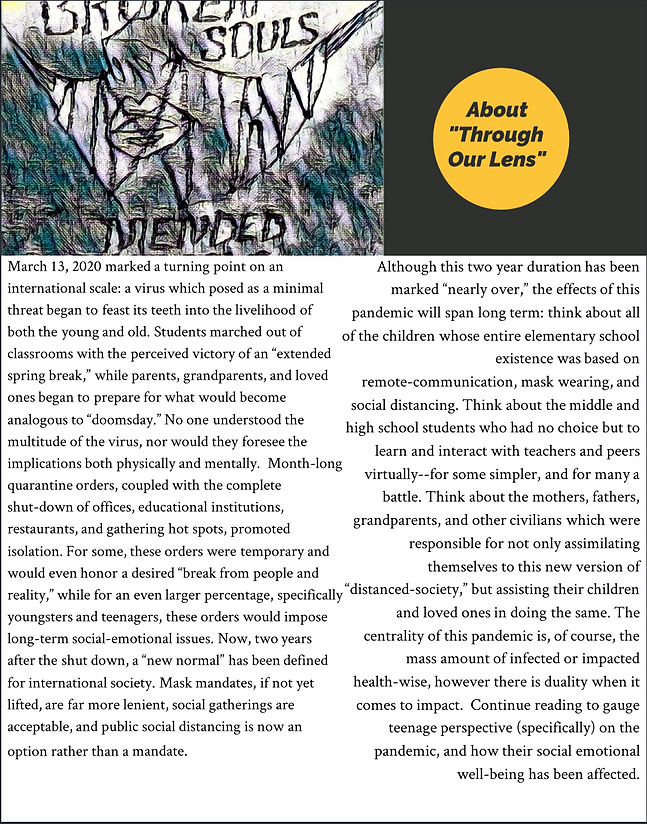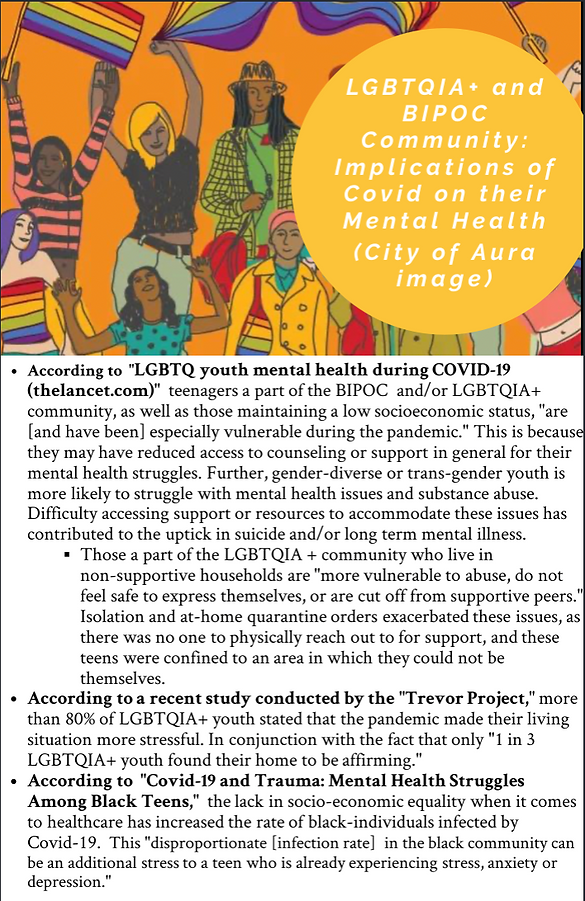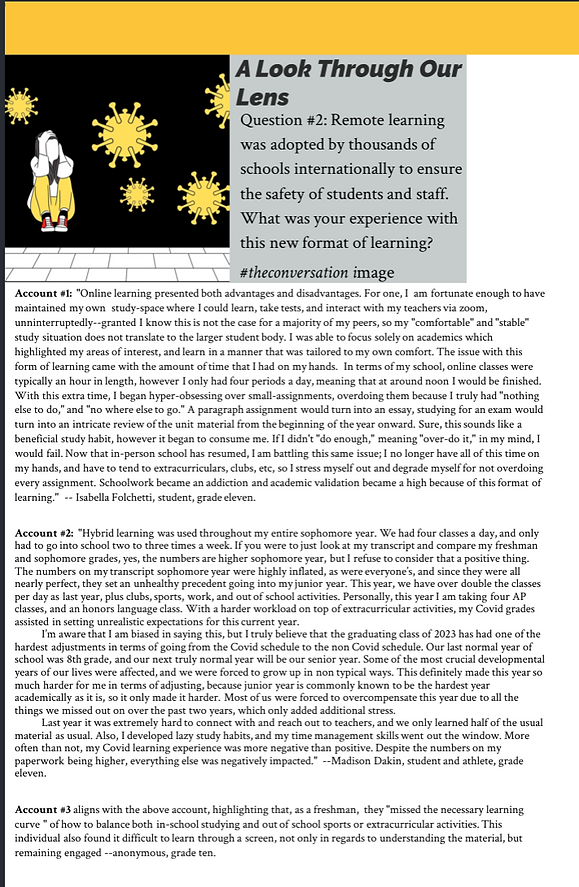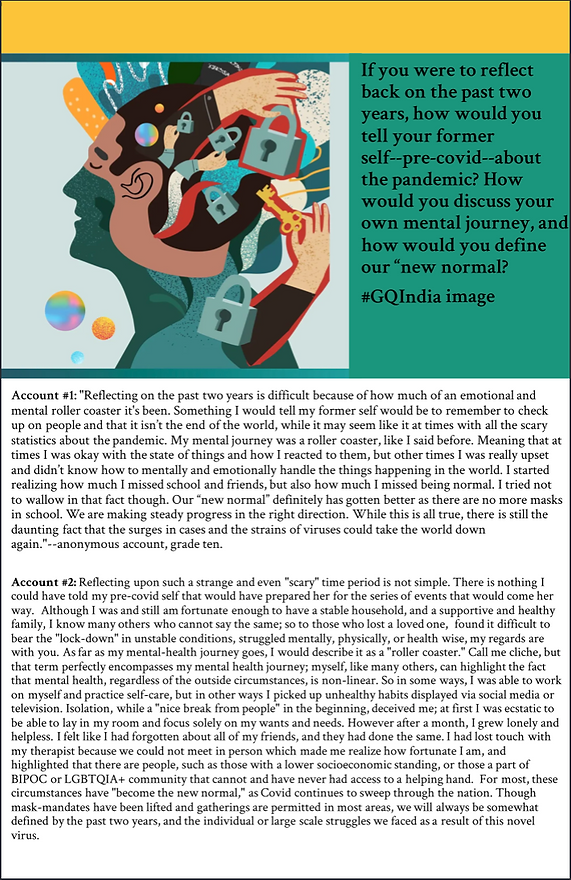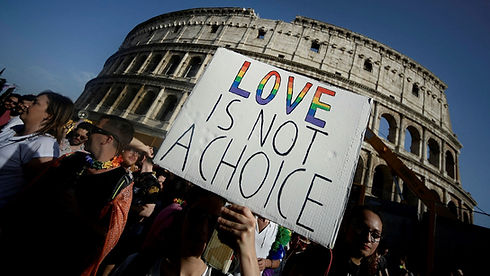"Through Our Lens" Journalism Hub
A gallery of alternative pieces of prose/articles/journalist newscasts (that can also be found on redefy.org). Timely, transcendent, and truthful literary works that serve to empower, acknowledge, dispel, or amplify awareness.
While securing the right to bodily autonomy is imperative, it is equally as important to consider the historical context of this right, and how it polarized women inter-domestically—promoting privilege rather than universal liberty.
The Dangers of a Safe Word
The origins of the term “trigger warning” and how it has been revamped and utilized for promotion of mocking and emotional bruising, rather than barricading individuals from becoming upset or re-introduced to former trauma
Standardized Tests: Marker for “College Readiness” or for Socioeconomic and Racial Division?
How standardized tests such as the SAT, ACT, and other college-entry exams perpetuate socioeconomic and racial division more so than provide all students with a level playing field; lack of opportunity, access to education, or tools by lower-class individuals hinders performance overall, and access to the above materials showcases someones “intelligence or college readiness.” Why do college admissions continue to perpetuate this socioeconomic and racial disparity?
“Temporary” Implies Change That Can’t Be Accomodated
Social Media: The New Yellow Journalism (of the 21st Century)?
How the spread of misinformation or hyperbolized (facts), be it intentional or unintentional, has taken on a new fashion in the 21st century--comparable to that of 19th century Yellow Journalism--misrenders historical narrative, undermines the lives of those who are combating the disproven reality head on, or even vilifies certain aspects of history in order to sway public opinion in a desirable direction.
Slap Heard Around the World: The Voices We Didn’t Hear As a Result
How the altercation --likely a publicity stunt-- between Chris Rock and Will Smith undermined the accomplishments of those who have and continue to pave the way for marginalized (communities), in turn curing the Academy’s fever for attention.
What If I Don’t Want a Label?
Society centers itself around labels, perhaps for stability or conformity. But why must we abide by those labels, specifically if they disregard our desires and instill in us a need to “conform” rather than interpret and outlet our own feelings and preferences?
Privilege VS Change: Why We Need To Reconsider Our Movement For “Bodily Autonomy."
While securing the right to bodily autonomy is imperative, it is equally as important to consider the historical context of this right, and how it polarized women inter-domestically—promoting privilege rather than universal liberty.
Their Feet, our Fall: Active Attempt to Debunk Civil Liberties for Non-White Individuals in order to salvage the “White Institution”
How the “Great Replacement Theory” has promoted heinous violence and attempts to target certain demographics who are believed to be “replacing” or taking over the “white institution,” and dominating based on their acquired human rights.

Honing in on an Interglobal Issue: Drug Addiction, Specifically in the context of the United States
(ima
(image courtesy, time.com (special report regarding Opiod Epidemic)
Surveying the taxonomic definition of drug addiction; the causes of drug addiction specifically in the context of sociological and biosocial pattern and context and enduring feedback loop(s), the effects or implication(s) of drug addiction, socially, economically, politically, and interpersonally (regarding nuerological and mental health): and highlighting a warrant for prevention through assistance, through access, and through proper education/resources that serve to prevent or to rehabilitate should the individual be actively addicted, rather than to reprimand and punish, with minimal effect in regards to curbing large-scale drug addiction.
A Radically Raised Consciousness: The Notion that Homophobia Exceeds Emotional and Social Implications -- a definition rendered on behalf of the oppressors to further silence the oppressed -and is Inherently Systemic.
(ima
(image courtesy, financialtimes.com) the active deep dive into the utterly philosophical definition of homopobobia, the manner in which homophobia is defined socially and emotionally -- and considered to be a medical prognostic -- and the warrant for dismantling a radical and raised conscious which regards the notion that this "medical prognostic" is to excuse ill-intention and a gross misconstruing of human rights and liberty: honing in on systemic implications of homophobia interglobally, those differing modes of homophobia (personal, interpersonal, institutional) and the manner in which all of the aforementioned collaborate or re outletted in order to dehumanize, to discriminate, or to gravely punish those a part of the LGBTQIA -- and the warrant for inclusive and intersectional reform in order to ensure that this community is with proper rights and liberties, and is without enduring stigmatic designations which regard their "mental illness" or their warrant for grave punishment, or stongng, or chemical clearing -- in order to curb some format of contagion.
Through Our Lens
"Out-Coming": Our Narratives Which Clothe and Polish an Alternative, More Inclusive, Common Grain
Our open-faced magazine which underscores individual grapple with actualizing their sexuality, gender or sexual orientation, or their overall identification within that of the larger LGBTQIA+ umbrella/acronym. To highlight both sameness and difference, intersection points, in which these individual narratives stand or resonate, and how the heteronormative — which is seemingly the backbone of society, unrightfully so— or what “should be” in terms of sexual and gender orientation, has influenced an unwelcoming, rawly rejecting empirical that serves to discriminate, dehumanize, or make mere “degenerates” those who do not fit neatly within the narrative. The larger warrant for change which is implicit within each individual individual coming out story, and how we will proceed to take action in order to highlight inclusive and intersectional liberties for all a part of the LGBTQIA+ community (specifically those who are chalky disadvantaged or discriminated against on the basis of their cultural background, beliefs, or values), to pave the way for what is a welcoming embrace — so that there is no hesitance when it comes to the act of coming out, and there is no raw rejection, nor is there artificial acceptance. There is, rather acknowledgment, recognition, and notion of equity and equality that provides for all persons, regardless of their socio-political status, cultural background, or identification within the LGBTQIA+ community.
NARRATIVE #3 BELONGS TO REDEFYCALIFORNIA CHAPTER LEADER, Isabella Folchetti. THIS COMING OUT AUDIO IS A TRANSLATION -- RATHER THAN TRANSCRIBED OR TYPED -- NARRATIVE OF STUDENT, OCEANE JONES!








Through Our Lens Feature
Definition of Religious Inequality: An Enduring Issue Which Spans Inter-globally
While securing the right to bodily autonomy is imperative, it is equally as important to consider the historical context of this right, and how it polarized women inter-domestically—promoting privilege rather than universal liberty.

(image courtesy of workingnowandthen.com (not sponsored nor intended to solicit or encourage business)
Definition of Religious Inequality: An Enduring Issue Which Spans Interglobally
To discriminate against a person or group of persons based on their religious practices, beliefs, and values, or lack thereof, is to promote religious inequality: to dehumanize and to subject to extreme acts of hatred or violence which place the targeted groups in physical danger based solely on religious difference, is to promote religious inequality. Although there is a severity spectrum on which this religious inequality falls, it is a result of endemic intolerance: the inability to accept or unite based on both similarity and difference in religious beliefs, but rather the ability to divide, separate, and level one practicing religion lower than the other.
Causes:
There is no “one cause” of religious inequality, nor is there an established severity on which this inequality and discrimination is executed. The “building blocks” of this inequality is rooted in the following:
-
Superiority or Savior Complex → similar to the “White Man’s Burden,” published in 1899, some believe that it is the “duty” of the “superior folk” of “superior practices” to nurture and civilize those whose origins lie in a different culture/country and set of religious beliefs. As if those who do not abide by one Christian denomination and one Anglo-Saxon way of life (specifically in the New World) are uncivilized and warrant re-working or re-framing in terms of values, beliefs, or practices.
-
The attempt to civilize is often coupled with manipulation and degradation: making it seem as if those who practice a religion outside of what is considered “acceptable” in a specific region or nation are in the minority and therefore must learn to assimilate. If they are not willing to do so, they will “reap the consequences of discrimination, inequality, and inferior leveling,” based on their religious beliefs and devotion.
-
-
The General Nature of Religious Institutions → “religions, by their nature, tend to be intolerant to other religions.” This intolerance is often staked in conflicting beliefs about one or many deities, the way in which each deity should be worshiped, and what is stated in the collection of religious texts and scriptures about the contents of the religion and how those contents should be honored.
-
“When a religion is closely associated with the state, this makes the government more likely to discriminate against minority religions”1–that is, if the First Amendment's guarantee of the separation of Church and State—a right guaranteed only by the US Constitution—does not apply. When this occurs, one religion serves as the cornerstone upon which a country or state is built, while religions (and adherents of this religion) that diverge from the "foundation" are destroyed, dishonored, or subjected to discrimination.
-
-
Ignorance, Pre-Assumption, and Stereotypes → Many individuals choose to remain unknowledgeable, uneducated, or ignorant, by refusing to understand or simply inquire about the contents or basic beliefs of an unfamiliar religion; they instead use pre-assumption, stereotypical thought, or image/characteristics displayed on the media to shape what they believe to be the contents and practices of this religion.
Effects:
Religious Inequality is not native to one nation, nor is any one nation immune to this inequality: here are the effects of said religious inequality exemplified through national jurisdiction.
In the Netherlands, religious freedom is seemingly ample. Societally speaking, there is no distinction made between specific religions in terms of what practices are considered ethical and what are considered unethical. Every individual is provided with the liberty to choose what religious or ideological beliefs they wish to indulge in2, just as they are provided the liberty to not indulge in any one belief system. Scholastically speaking, there are public academic institutions which are not catered to one specific belief system: welcoming a diverse palette of religious practices without discrimination, or instruction that is aimed at degrading one or many of those religious practices. There are also several private institutions which are founded on the principles of Protestantism, Catholicism, Islam, or Judiasm; while the curriculum and extracurricular events are catered to one specific practice, and a majority of the attending body does practice the target religion, these institutions are still without a warrant for discrimination. Many of these schools, according to iamexpat.nl, are “moderate” in terms of the way in which they integrate their religious beliefs into the curriculum at hand; they welcome children with a religion separate from the target, as well as children without a religion.
Religious inequality occasionally slips through the seeming impenetrable seams even in a country that was founded on religious tolerance and fluidity, where the Constitution forbids discrimination based on different cultural or religious views or practices.. For instance, according to the 2021 Report on International Religious Freedom in the Netherlands, parliament has actively attempted to defund or “counter foreign funding” for Mosques and Islamic Institutions. The incentive being to “halt the influence of Salafist--to execute reform on behalf of the Sunni branch of Islam-- or radical ideas” that perhaps do not align with the religious institutions and practices already present in the Netherlands. Furthermore, according to this same report, both government and non-governmental organizations have documented “hundreds of anti-Muslim and anti-semetic incidents involving non-lethal violence, threats, harrassment, discrimination, hate speech, and vandalism.”3 Statistically speaking, “police registered a sum of 517 antisemetic incidents as of 2020, [and] of those incidents, 17 of them involved vandalism, and 27 of them involved some form of violence.” And while there was a drastic decrease in the registered incidents of outright religious discrimination--specifically against Muslims--relative to the previous two years (2019), there still was a yield of 180 incidents which highlighted that discrimination. This proves that there are minimal to no nations that highlight LACK of conflict of interest or religion: even in a nation where a majority of the students are cushioned rather than condemned for their individual practices, and even in a nation where a majority of persons are able to practice freely in social/public situations, there are still demographics which are systematically discriminated against: a default minority, unlawful and unrighteous, staked in popularized institutions and beliefs that are considered the “societal normal” relative to alternative religions or institutions which may be native to a different nation/country.
Nations in the same liberty-likelihood as the Netherlands, such as the United States and the United Kingdom, strive to cushion all citizens with freedom of religion and cultural expression: as highlighted by the first amendment of the United States Constitution, “congress shall make no law respecting an establishment of religion, or prohibiting the free exercise thereof.”4 And as highlighted by the Human Rights Act of 1998 established in the United Kingdom, which has since been repealed by the 2022 Bill of Rights Bill, “the right to freedom of religion and belief is protected.”5 Similar to that of the Netherlands, even with this constitutional cushion, there are still instances in which religious inequality and intolerance are prevalent. Prejudice against Muslims, otherwise referred to “Islamophobia,” has remained severely underreported in the United States since the 9/11 terrorist attack. Generalization and scapegoating are the grounds on which Islamophobia stakes itself; and these forms of discrimination have increased by roughly nine percent in the past two years--spanning from April of 2020 to April of 2022. 6Muslim-American communities have fallen subject to “surveillance, deportation, questioning, and other harassment by local and federal law enforcement with [minimal] accountability in sight,” solely on the basis of their religious practices and values. This narrative--surrounding discrimination against those who actively practice the Islamic religion--holds true in the United Kingdom just as much as it is solidified in the United States. Societally speaking, “seven out of ten Muslims [actively] employed in the United Kingdom have experienced some form of anti-Muslim behavior in the workplace, [be it through] interactions with customers, clients, or other people during social/ work-related events.” 7 There is no doubt that religious prejudice and discrimination at work immediately affect ordinary social interactions, conversations, or encounters.. By the same token, discrimination against those who practice Judaism, otherwise referred to as “anti-semitism,” has tagged itself in both the United Kingdom, with a sum of nearly 871 anti-semetic incidents throughout 82021 in the context of colloquial conversation, classroom and workplace settings, etc, and the United States, with a sum of 2,717 anti-semetic incidents also throughout 2021 in the same abovementioned context(s). 9
While the nations mentioned above, as well as Canada, Australia, Denmark, New Zealand, and Sweden have established acts, laws, or bills that pose as sponges--which sop up any remnants of religious inequality or discrimination–there are other countries that openly support religious discrimination by acts of violence, hate speech, hostilities, or genocide. Several countries, like Burma, North Korea, Saudi Arabia, and Sudan, were established on the basis of religious prejudice through extreme violence, hatred, bloodshed, or genocide. The religion central to Berma is Theravada Buddhism–attaining self-liberation through one’s own efforts and individual Buddhist practice: roughly 88% of Burma’s population stakes itself in Buddhist practices,10 and the remaining 12% is rooted in Christianity, Islam, and Hinduism: otherwise considered the “religious minority.” Religious and ethnic minorities in Burma, “particularly Rohingya Muslims,” are reportedly “scorched [or plagued] by bigotry and intolerance.” They are fronted with abuse, violence, severe hatred, and the inability to be granted citizenship by the Burmese government11: they are considered “those that do not belong.” North Korea is statistically considered an “atheist state,” and “one of the most oppressive regimes and worst violators of human rights,” in which “genuine freedom of religion or belief is non-existent.”12 Incessant threat of torture, imprisonment, and even death is provided to those who attempt to bode against the common grain or default atheist religion: there is no room for religious fluidity, and should an individual devote themselves to any other religious practice, they would reap the severe penalties or consequences established directly on behalf of the government. In Saudi Arabia, the default or most practiced religion is Sunni Islam: “freedom of religion is neither recognized nor protected governmentally,13” meaning that those who practice a different sect of the Islamic religon--Shia, for instance--or a different religion entirely, are subjected to severe discrimination. The government enduringly “uses criminal charges of blasphemy--speaking sacrilegiously--to suppress dialogue between dissenting viewpoints,”14 and has enacted “The Penal Law for Crimes of Terrorism,” founded entirely on the criminalization of dissenting viewpoints. In order to prevent alternative Islamic sects or any other religion from endangering its main institution, the jurisdictional motivation is to quiet those who have alternative religious beliefs in the areas of government, society, and education. In Sudan, Islamization and strict interpretation of Sharia Law make virtually impossible the ability to practice religion freely: nearly “97% of the country’s population” actively devotes itself to the Islamic religion, however with the other 3% comes an abundance of religious diversity which is dismantled and dishonored by the jurisdiction. A string of laws, including but not limited to the 1991 Criminal Code and the 1991 Personal Status Law of Muslims, has been established to counter the “country’s constitutional and international commitments to human rights and freedom of religion,” permitting “death sentences for apostasy--abandonment of a religious practice or belief--and prison sentences for blasphemy.” 15 All of the aforementioned countries experience internal strife and injustice, which encourages them to silence or condemn people who appear to be a "threat" to their religious institution. As demonstrated by the ongoing conflict in the Middle East, including but not limited to the ongoing Israeli-Palestinian conflict, religious inequality and outright or brute force used as a tool of discrimination, are justified. External conflict is too frequently related to or exacerbated by religious differences..
Solutions:
In order to curb religious discrimination and inequality, the following must be either pursued, practiced, or established–-societally speaking, as well as work-place and governmentally speaking.
-
Understanding what constitutes the religious discrimination and religious inequality throughout a public vicinity, workplace, or colloquial environment. Identifying where both discrimination and inequality is present throughout one given nation, state, or region, and working to dismantle said discrimination and inequality (societally).
-
Establishing a “Zero Tolerance Policy” throughout work-places and throughout public vicinities in order to ensure that there is no encouragement of discrimination based on differing cultural and religious practices: building a "safe place" that is inclusive, intersectional, and equally comprehensive by punishing those who willfully discriminate against a group and giving compensation and equal opportunity to those who were discriminated against.
-
This “zero tolerance policy” is only plausible for religously fluid and free nations, such as the United States, United Kingdom, Netherlands, etc; in nations such as Sudan, Burma, North Korea, and Saudi Arabia, there would be no backing for this policy, and instead of providing punishment for those who were outwardly discriminatory, there would be a punishment for those who were discriminated against–-for not abiding by the religious practices and beliefs on which the nation was founded on.
-
-
A solution for the religiously rigid nations, such as Sudan, Burma, North Korea, and Saudi Arabia would be to consider, on an international or global scale, the manner in which neighboring nations approach religious difference: perhaps emulating enactments, “no tolerance policies,” and laws concerned with human rights, liberties, and equality. Instead of completely abandoning the religious principles on which these nations stand, said nations can alter these tenets and create space for freedom and flexibility, allowing people to practice whichever religion they choose without facing repercussions as long as they uphold the ideals on which the country was built. Both distinct or varied religious practices are protected by (possible) enactments or legislation.
Pride Month Release
Through Our Lens
Our open-faced infographic which underscores the personal perspectives of those a part of the LGBTQIA+ community, or those who resonate with the community. Instances of struggle, oppression, and even inability to recognize one's own identity is highlighted in this magazine, as are the necessary steps we need to take to promote inclusivity and acceptance.


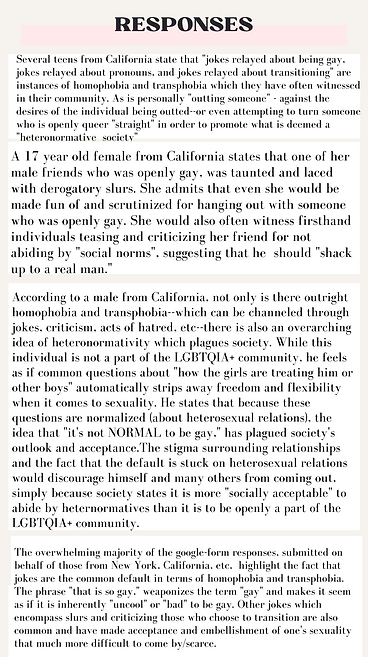


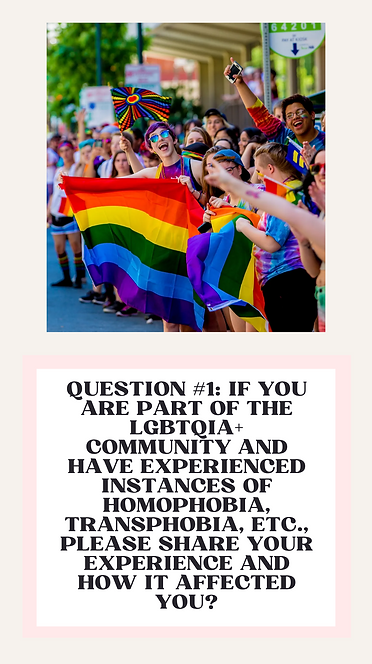


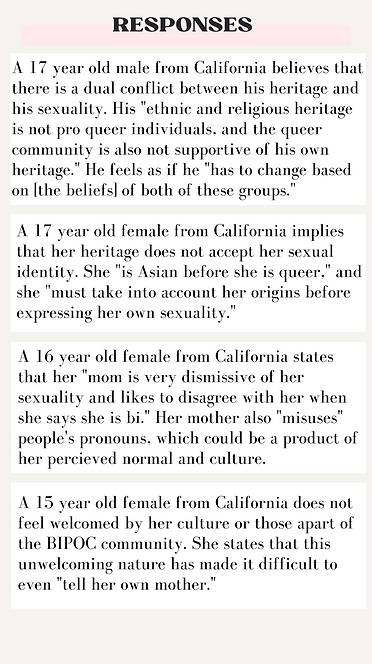


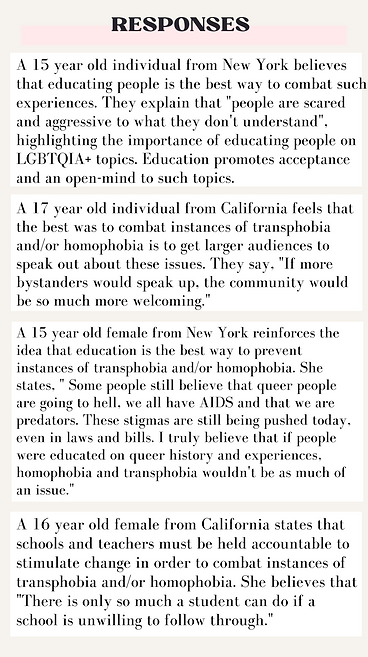


Through Our Lens
Victim to the Pandemic's Victory
Our open-faced magazine which underscores raw teenage perspectives on the pandemic and how it has impacted social-emotional being.




